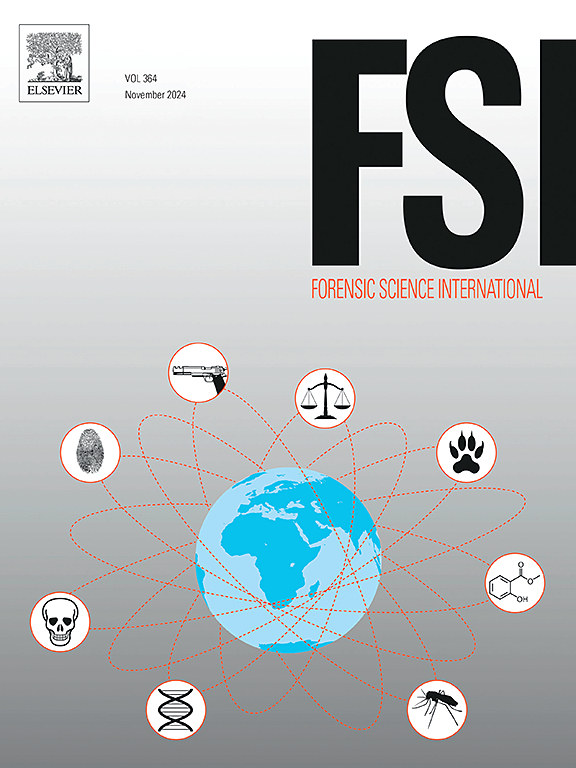叙利亚难民转介到法医诊所的主要原因中的年龄和性别差异:一项为期一年的横断面研究
IF 2.2
3区 医学
Q1 MEDICINE, LEGAL
引用次数: 0
摘要
叙利亚人是全球最大的难民人口,主要由土耳其政府收容。由于冲突导致的流离失所及其不安全的移民身份,许多人获得基本人类需求的机会有限,并因被迫流离失所而进一步产生心理健康问题。该研究旨在确定对叙利亚难民中特定年龄组和性别进行法医评估的原因。方法对781名叙利亚难民的人口统计和病例信息进行描述性研究,其中74.6% %为男性,25.4% %为女性,这些难民因精神药物检测、年龄估计、DNA分析、损伤评估和法医精神病学评估等五个主要原因被转到法医学诊所。患者信息是从患者文件中收集的。名义数据按性别和4个不同年龄组分类:儿科(0-14岁)、青少年(15-24岁)、青年(25-34岁)和成人(35岁及以上)。结果在14岁以上的男性中,药物检查是最常见的原因(79.7% %),女性难民中,年龄估计是因为早婚(53.3% %)。DNA检测是女性成年的主要原因。大多数难民的伤无法用简单的药物治疗(89.2% %男性,58.8% %女性)。儿童损伤评估显示头部损伤(33.3% %),不能用SMT治疗(100% %),其中33.3% %的病例危及生命。结论根据人口统计、性别和年龄识别叙利亚难民中的弱势群体将进一步促进更有效的方法来改善干预措施。本文章由计算机程序翻译,如有差异,请以英文原文为准。
Age and gender differences in leading reasons for referral to forensic medicine clinic among syrian refugees: A one-year cross-sectional study
Background
Syrian people are the largest refugee population globally and are mainly hosted by the Turkish government. Due to the conflict-driven displacement and their insecure immigration status, many have limited access to basic human needs and develop further mental health issues due to forced displacement. The study aims to identify reasons for forensic evaluation in specific age groups and gender among Syrian refugees.
Methods
For this descriptive study, the demographic and case information of 781 Syrian refugees, consisting of 74.6 % males and 25.4 % females who are referred to the Forensic Medicine Clinics due to five main reasons: psychoactive drug testing, age estimation, DNA analysis, injury assessment, and forensic-psychiatric evaluation were included. The patient information is collected from the patient files. The nominal data were categorized by gender and under 4 different age groups: pediatric (age 0–14), adolescent (age 15–24), young adult (age 25–34), and adult (age 35 and older).
Results
Drug tests were the most prevalent reason in males older than 14 years old (79.7 %), and age estimation, due to early marriages for the female refugees (53.3 %). DNA testing was the primary reason for female adults. The majority of the refugees’ injuries were untreatable with simple medical treatment (SMT) (89.2 % males, 58.8 % females). Pediatric injury assessments demonstrated head injuries (33.3 %), not treatable with SMT (100 %), and 33.3 % of those cases were life-threatening.
Conclusion
Identifying vulnerable individuals among the Syrian refugee population based on demographics, gender, and age will further promote more effective approaches to improve the interventions.
求助全文
通过发布文献求助,成功后即可免费获取论文全文。
去求助
来源期刊

Forensic science international
医学-医学:法
CiteScore
5.00
自引率
9.10%
发文量
285
审稿时长
49 days
期刊介绍:
Forensic Science International is the flagship journal in the prestigious Forensic Science International family, publishing the most innovative, cutting-edge, and influential contributions across the forensic sciences. Fields include: forensic pathology and histochemistry, chemistry, biochemistry and toxicology, biology, serology, odontology, psychiatry, anthropology, digital forensics, the physical sciences, firearms, and document examination, as well as investigations of value to public health in its broadest sense, and the important marginal area where science and medicine interact with the law.
The journal publishes:
Case Reports
Commentaries
Letters to the Editor
Original Research Papers (Regular Papers)
Rapid Communications
Review Articles
Technical Notes.
 求助内容:
求助内容: 应助结果提醒方式:
应助结果提醒方式:


